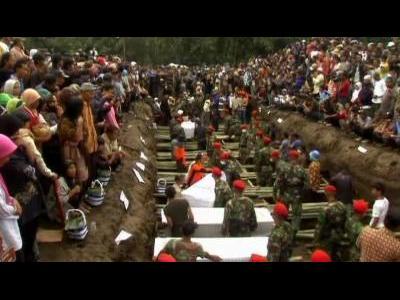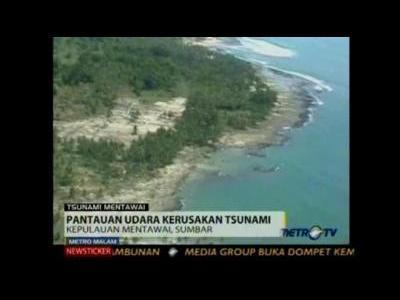Shortage of boats slows aid for Indonesia tsunami
MENTAWAI ISLANDS, Indonesia – A shortage of boats is slowing delivery of tons of food, water and blankets in the remote Indonesian islands hit hardest by a tsunami that killed more than 400 people and crushed entire villages, an official said Friday.
On the main island of Java, a volcano that killed 33 people this week erupted five more times Friday, sending searing clouds of ash cascading down its slopes but no more casualties were reported.
Dozens of injured survivors of the tsunami languished at a sorely strapped hospital alongside a newly orphaned 2-month-old baby found in a storm drain. The injured lay on mats or the bare floor as rainwater dripped onto them from holes in the ceiling and intravenous cords hung from plastic ropes strung from the rafters. The baby, its lungs filled with fluid and with cuts on its face, blinked sleepily in a humidified crib.
"We need doctors, specialists," nurse Anputra said at the tiny hospital in Pagai Utara — one of the four main islands in the Mentawai chain slammed by Monday's tsunami.
A relief coordinator acknowledged Friday that aid was being held up. Suryadi, who is coordinating the aid response from West Sumatra, said tons of aid has reached the main towns on the worst-hit islands by helicopter, after rough seas kept boats away for two days.
However, rescue workers say they can't deliver that aid to further-flung coastal villages that are accessible only by foot or by sea because roads are too old or damaged for large trucks.
"We need more boats," Suryadi said. He could not estimate how many boats are now delivering aid, but most of the islands' craft would have been washed away by the wave and helicopters have no place to land in many of the devastated villages.
The toll from the tsunami and the 7.7-magnitude earthquake beneath the Indian Ocean that spawned it rose to 408 on Friday as officials found more bodies, and 303 people were still missing and feared swept out to sea, said Agus Prayitno of the West Sumatra provincial disaster management center.
Along with the 33 people killed by a volcano that erupted Tuesday more than 800 miles (1,300 kilometers) to the east in central Java, the number of dead from Indonesia's twin disasters this week has now reached 441.
After a lull that allowed mourners to hold a mass burial for victims, Mount Merapi rumbled with three small eruptions Thursday and five early Friday — easing pressure and possibly making another big eruption less likely. There were no reports of new injuries or damage.
The catastrophes struck within 24 hours in different parts of the seismically active country, severely testing Indonesia's emergency response network.
Aid workers trickling into the remote earthquake- and tsunami-struck region found giant chunks of coral and rocks in places where homes once stood. Huge swaths of land were submerged. Swollen corpses dotted roads and beaches.
At the hospital on Pagai Utara, 35-year-old Sarifinus cradled his 5-year-old son, Dimas, who screamed as medical staff tended to his broken arm.
The man described how, when the towering wall of water came, he grabbed his two other young sons and ran toward the mountain. The wave tore both from his arms and sucked them away.
Sarifinus and his wife, Martina, who sat staring blankly in a corner of the hospital, found Dimas alive after the waters receded.
One of the hardest-hit areas with 65 dead was the village of Pro Rogat on Pagai Seatandug island.
Villagers there huddled under tarps in the rain and told how many people who had fled to the hills were now too afraid to return home.
Mud and palm fronds covered the body of the village's 60-year-old pastor, Simorangkir. He lay on the ground, partially zipped into a body bag. Police and relatives took turns pushing a shovel into the sodden dirt next to him for his grave.
"Everybody here is so sad," his 28-year-old grandson, Rio, said as relatives prepared to lay the pastor in the grave.
At the Mount Merapi volcano, hot clouds of ash spewed from the mountain at 6:10 a.m., 8:40 a.m. and 11:19 a.m. Friday, according to Subandriyo, a senior government volcanologist.
The activity appeared to be easing pressure behind a lava dome that has formed in the crater, said Safari Dwiyono, a scientist who has been monitoring Merapi for 15 years.
"If the energy continues to release little by little like this, it reduces the chances of having a bigger, powerful eruption," he said.
Residents from Kinahrejo, Ngrangkah, and Kaliadem — villages that were devastated in Tuesday's blast — crammed into refugee camps. Officials brought cows, buffalo and goats down the mountain so that villagers wouldn't try to go home to check on their livestock.
Thousands attended a mass burial for 26 of the victims six miles (10 kilometers) from the base of the volcano. Family and friends wept and hugged one another as the bodies were lowered into the grave in rows.
___
Associated Press writers Achmad Ibrahim in the Mentawai islands, Slamet Riyadi at Mount Merapi and Irwan Firdaus in Jakarta contributed to this report.




Tidak ada komentar:
Posting Komentar